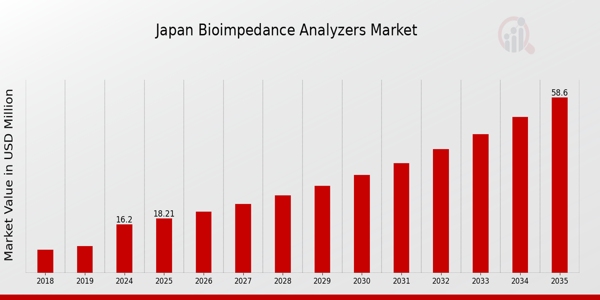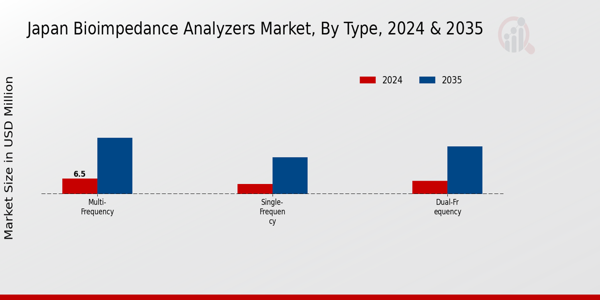Japan Bioimpedance Analyzers Market Overview:
As per MRFR analysis, the Japan Bioimpedance Analyzers Market Size was estimated at 14.76 (USD Million) in 2024.The Japan Bioimpedance Analyzers Market Industry is expected to grow from 16.2(USD Million) in 2025 to 58.6 (USD Million) by 2035. The Japan Bioimpedance Analyzers Market CAGR (growth rate) is expected to be around 12.399% during the forecast period (2025 - 2035).
Key Japan Bioimpedance Analyzers Market Trends Highlighted
The Japan Bioimpedance Analyzers Market is witnessing significant market trends, driven by the increasing health concerns among the aging population. With Japan having one of the highest life expectancies in the world, there is a growing demand for effective health monitoring technologies, which bioimpedance analyzers provide. These devices enable healthcare professionals to assess body composition, hydration status, and overall health more accurately, making them essential tools in clinical settings and wellness programs.
Furthermore, the rise of lifestyle-related diseases such as diabetes and obesity has fueled the necessity for regular health assessments, propelling the adoption of bioimpedance technology.Opportunities in this market continue to expand as advancements in technology lead to the development of more sophisticated and user-friendly bioimpedance devices. The integration of smartphone applications and telehealth platforms with bioimpedance analyzers presents a substantial opportunity for both manufacturers and healthcare providers to enhance patient engagement and personalize health monitoring.
Additionally, as the Japanese government emphasizes preventive healthcare in its health initiatives, this aligns with the growing utilization of bioimpedance devices in both clinical and home settings. Recent trends in Japan also include a shift toward preventive health care solutions.The government’s promotion of health management and disease prevention has encouraged the incorporation of bioimpedance analysis in routine health checks.
As a result, more healthcare establishments are adopting these analyzers to meet regulatory guidelines and improve patient outcomes. The focus on chronic disease management and overall wellness has led to an increased focus on the bioimpedance analyzers market, reflecting a broader trend in Japan’s healthcare landscape, where technology is being leveraged to enhance health monitoring and management.

Source: Primary Research, Secondary Research, MRFR Database and Analyst Review
Japan Bioimpedance Analyzers Market Drivers
Increasing Prevalence of Lifestyle Diseases
The rising incidence of lifestyle diseases such as obesity, diabetes, and hypertension in Japan is a significant driver for the Japan Bioimpedance Analyzers Market Industry. According to the Ministry of Health, Labour and Welfare of Japan, approximately 30% of Japanese adults are considered overweight, and the prevalence of type 2 diabetes has surged by 13% over the past decade.
This increase necessitates effective monitoring of body composition, which bioimpedance analyzers provide.With major hospitals and health clinics like Keio University Hospital and St. Luke's International Hospital investing in advanced bioimpedance technologies, the demand for these devices is expected to grow substantially. The ability to monitor body fat and muscle mass using bioimpedance analysis offers a crucial tool for healthcare professionals and individuals alike in managing these prevalent conditions.
Technological Advancements in Bioimpedance Devices
The Japan Bioimpedance Analyzers Market Industry is experiencing significant growth due to continuous technological advancements in bioimpedance technology. The development of portable and user-friendly bioimpedance analyzers has made these devices more accessible. A recent patent filing from a leading Japanese firm has disclosed innovative features such as wireless connectivity and AI-driven analytics, thereby enhancing user experience and data interpretation.
The Japanese government's initiative to promote health technology innovation is evident through its funding programs supporting Research and Development in medical devices. This focus on technological progression is projected to drive the uptake of bioimpedance analyzers in hospitals and home healthcare settings.
Aging Population and Demand for Health Monitoring
Japan has one of the highest life expectancies globally, resulting in a rapidly aging population. As of 2021, over 28% of the population was aged 65 and older, according to the Statistics Bureau of Japan. This demographic shift has led to an increased demand for health monitoring solutions, including bioimpedance analyzers that are effective in assessing muscle mass and fluid retention. Organizations such as the Japan Geriatrics Society are advocating for regular health assessments among elderly citizens, propelling the market forward.As health care professionals start using bioimpedance analysis in their routine evaluations of elderly patients, the Japan Bioimpedance Analyzers Market Industry will grow tremendously.
Growing Awareness of Preventive Healthcare
There is a rising trend in Japan towards preventive healthcare, driven by increasing health awareness among consumers. The Japanese government has launched several public health campaigns emphasizing the importance of regular health screenings and lifestyle management. A survey conducted by the Japan Health Promotion Foundation indicated that nearly 60% of respondents are now more conscious of their body composition in relation to health impacts.
This surge in health consciousness has led to an increase in sales of bioimpedance analyzers, as individuals seek to monitor their health more proactively.With retail chains like Don Quijote and online platforms promoting bioimpedance devices, the Japan Bioimpedance Analyzers Market Industry is witnessing growing consumer interest and investment.
Japan Bioimpedance Analyzers Market Segment Insights:
Bioimpedance Analyzers Market Type Insights
The Japan Bioimpedance Analyzers Market is evolving significantly, driven by advancements in technology and the increasing awareness of health monitoring systems. Within this marketplace, the Type segment can be broadly categorized into Multi-Frequency, Single-Frequency, and Dual-Frequency analyzers, each exhibiting its own unique characteristics and advantages. Multi-analyzers are notable for their ability to provide comprehensive body composition analysis, delivering more accurate readings by measuring at different frequencies.
This capability allows healthcare professionals to assess hydration levels, fat mass, and lean body mass more effectively, which is particularly important in Japan where there is a growing emphasis on preventive healthcare and personalized medicine.On the other hand, Single-Frequency analyzers are simpler and often more affordable, catering to scenarios where basic body composition such as total body water content suffices. Their minimalist design appeals to smaller clinics across Japan that are adopting bioimpedance technology into routine examinations.
Meanwhile, Dual-Frequency analyzers blend the functionalities of both types, offering a balanced approach that can cater to various clinical requirements without the complexities of handling multi-frequency data, thus making them significant in managing patient care efficiently and effectively.The demand for bioimpedance analyzers in Japan can be attributed to factors such as the rising incidence of obesity and related health issues.
Furthermore, the increasing utilization of these devices in fitness and wellness sectors is providing ample opportunities for market growth. The focus on enhancing the accuracy and reliability of bioimpedance measurements continues to drive product innovation, positioning the Japan Bioimpedance Analyzers Market as a dynamic and robust industry catering to health and wellness needs.

Source: Primary Research, Secondary Research, MRFR Database and Analyst Review
Bioimpedance Analyzers Market Modality Insights
The Japan Bioimpedance Analyzers Market showcases a significant focus on the Modality segment, which encompasses both Wired Bioimpedance and Wireless Bioimpedance technologies. The increasing adoption of bioimpedance analysis in clinical and research settings reflects the demand for accurate body composition analysis, which is crucial in managing health-related issues such as obesity and chronic diseases. Wired Bioimpedance technology has historically been essential in providing reliable data in controlled environments, often preferred for its stability and accuracy.
On the other hand, the Wireless Bioimpedance modality is gaining traction due to its convenience and user-friendly features, enabling seamless integration into various health monitoring systems, particularly appealing in the era of telemedicine and remote patient monitoring. The rise in health consciousness among the Japanese population, combined with governmental support for advanced healthcare technologies, bolsters the growth of these modalities.
As an aging population in Japan turns toward preventive healthcare, both Wired and Wireless Bioimpedance analytics are becoming vital tools for healthcare providers, significantly contributing to the overarching objectives of the Japan Bioimpedance Analyzers Market.The aggressive pursuit of innovation and advancements in this technology further emphasizes its potential in transforming health assessments and management practices nationwide.
Bioimpedance Analyzers Market Application Insights
The Japan Bioimpedance Analyzers Market, particularly within the Application segment, showcases a dynamic landscape with a focus on Whole-Body Measurement and Segmental Body Measurement. Whole-Body Measurement plays a critical role in assessing overall health and body composition, providing vital data for clinical and research purposes. This method is particularly significant in Japan, where the prevalence of obesity and related health issues drives the demand for accurate body composition analysis.
Conversely, Segmental Body Measurement allows for targeted assessments of specific body parts, enabling healthcare professionals to tailor interventions based on precise measurements.This capability is increasingly being recognized in rehabilitation settings and athletic performance monitoring, where understanding segmental differences can lead to better health outcomes.
The growing trend of personalized healthcare in Japan further bolsters the relevance of these applications, where data-driven insights are crucial to improving patient care and outcomes. As the healthcare sector continues to embrace innovative technologies, the prominence of these measurement techniques is likely to expand, aligning with the country's commitment to enhancing public health and wellness initiatives.
Bioimpedance Analyzers Market End User Insights
The Japan Bioimpedance Analyzers Market demonstrates significant growth with a variety of end users contributing to its expansion. Hospitals play a crucial role in this market, utilizing bioimpedance analyzers for effective patient management and body composition analysis, thereby improving treatment outcomes. Fitness clubs increasingly incorporate these analyzers to tailor fitness programs to individual needs, which helps in attracting health-conscious clients.
Wellness centers emphasize overall health monitoring and prevention, making bioimpedance analysis an essential tool in their wellness initiatives.Home users benefit from easy-to-use bioimpedance devices that empower them to track their health metrics conveniently, appealing to Japan's aging population prioritizing personal health. The 'Others' category encompasses research facilities and universities that leverage these devices for various studies and developments in nutritional science and health technology.
Each segment organically contributes to the overall market growth by addressing unique health management needs and preferences in the Japanese landscape, significantly enhancing the functionality and acceptance of bioimpedance analyzers within the healthcare infrastructure.
Japan Bioimpedance Analyzers Market Key Players and Competitive Insights:
The Japan Bioimpedance Analyzers Market is characterized by its dynamic nature and the presence of significant players that contribute to advancements in medical diagnostics and healthcare solutions. This market focuses on devices that assess body composition and other physiological parameters through bioimpedance technology, which has gained traction in clinical and wellness settings. As the demand for precise and non-invasive diagnostic tools increases, understanding the competitive landscape is crucial for stakeholders.
Factors such as product innovation, regulatory compliance, distribution strategies, and partnerships play pivotal roles in shaping market trends. The competitive environment is underscored by the need for companies to enhance their technological capabilities and adapt to the evolving needs of healthcare providers and patients in Japan.Nihon Kohden stands out as a key player in the Japan Bioimpedance Analyzers Market, well-known for its innovative approach and commitment to quality.
The company leverages its extensive expertise in medical electronics to offer precise and reliable bioimpedance analyzers that cater to various healthcare settings including hospitals and clinics. With a strong emphasis on research and development, Nihon Kohden continuously integrates cutting-edge technology into its products, thereby enhancing patient care and improving clinical outcomes. The brand's established reputation in Japan solidifies its market presence, and its strong relationships with healthcare professionals further bolster its competitive edge.
The focus on delivering superior customer support and training for healthcare providers contributes to building loyalty among users in the competitive landscape.Selva, another influential entity in the Japan Bioimpedance Analyzers Market, presents a unique portfolio of products tailored to meet the diverse demands of the healthcare industry. The company specializes in bioimpedance measurements that aid in nutritional assessment and body composition analysis, which have become increasingly relevant in clinical practice.
Selva's strength lies in its ability to offer integrated solutions that combine bioimpedance technology with software applications, facilitating enhanced data interpretation for healthcare practitioners. The company has established a solid market presence in Japan and focuses on strategic partnerships and collaborations to expand its reach.
Recent mergers and acquisitions have allowed Selva to augment its technological capabilities and diversify its product offerings, enabling it to stay competitive and responsive to market dynamics in the region. This proactive approach underscores Selva's commitment to innovation and customer satisfaction within the Japanese healthcare landscape.
Key Companies in the Japan Bioimpedance Analyzers Market Include:
- Nihon Kohden
- Selva
- Soehnle
- Intelligence
- ImpediMed
- Fujifilm
- BioSpace
- DS Medica
- Omron
- Hitakey
- MediSensing
- Tanita
- InBody
- BodyMetrix
Japan Bioimpedance Analyzers Market Industry Developments
In recent developments within the Japan Bioimpedance Analyzers Market, major players such as Nihon Kohden and InBody have been expanding their product portfolios and enhancing technological innovations. Fujifilm has made strides in integrating bioimpedance technology into diagnostic solutions, emphasizing preventive healthcare, while Tanita continues to lead in the consumer health sector with affordable and user-friendly devices. In September 2023, ImpediMed announced a collaboration with DS Medica, focusing on novel applications of bioimpedance in clinical settings. Additionally, BioSpace is reportedly increasing its market presence through strategic partnerships aimed at research advancements. Previous years have seen significant growth, with the market valuation for bioimpedance analyzers in Japan rising steadily due to heightened demand in healthcare and fitness sectors. Notably, in November 2022, Omron enhanced its presence in the clinical diagnostics space by launching a new line of advanced bioimpedance devices. The Japanese government's push for improved health monitoring and disease prevention has further bolstered market opportunities. The trend indicates a continuous investment in Research and Development by various companies, ensuring the integration of cutting-edge technology in bioimpedance analysis.
Japan Bioimpedance Analyzers Market Segmentation Insights
Bioimpedance Analyzers Market Type Outlook
- Multi-Frequency
- Single-Frequency
- Dual-Frequency
Bioimpedance Analyzers Market Modality Outlook
- Wired Bioimpedance
- Wireless Bioimpedance
Bioimpedance Analyzers Market Application Outlook
- Whole-Body Measurement
- Segmental Body Measurement
Bioimpedance Analyzers Market End User Outlook
- Hospitals
- Fitness Clubs
- Wellness Centers
- Home Users
- Others
-
| Report Attribute/Metric Source: |
Details |
| MARKET SIZE 2018 |
14.76(USD Million) |
| MARKET SIZE 2024 |
16.2(USD Million) |
| MARKET SIZE 2035 |
58.6(USD Million) |
| COMPOUND ANNUAL GROWTH RATE (CAGR) |
12.399% (2025 - 2035) |
| REPORT COVERAGE |
Revenue Forecast, Competitive Landscape, Growth Factors, and Trends |
| BASE YEAR |
2024 |
| MARKET FORECAST PERIOD |
2025 - 2035 |
| HISTORICAL DATA |
2019 - 2024 |
| MARKET FORECAST UNITS |
USD Million |
| KEY COMPANIES PROFILED |
Nihon Kohden, Selva, Soehnle, Intelligence, ImpediMed, Fujifilm, BioSpace, DS Medica, Omron, Hitakey, MediSensing, Tanita, InBody, BodyMetrix |
| SEGMENTS COVERED |
Type, Modality, Application, End User |
| KEY MARKET OPPORTUNITIES |
Aging population increasing health monitoring, Rising demand for non-invasive diagnostics, Growing awareness of obesity management, Expanding applications in sports medicine, Technological advancements in bioimpedance devices |
| KEY MARKET DYNAMICS |
Growing aging population, Increasing obesity rates, Rising healthcare awareness, Advancements in bioimpedance technology, Demand for non-invasive diagnostics |
| COUNTRIES COVERED |
Japan |
Frequently Asked Questions (FAQ) :
By 2035, the Japan Bioimpedance Analyzers Market is expected to be valued at approximately 58.6 million USD.
In 2024, the Japan Bioimpedance Analyzers Market is valued at around 16.2 million USD.
The market is anticipated to grow at a CAGR of 12.399 percent from 2025 to 2035.
The Multi-Frequency segment is projected to grow to approximately 23.4 million USD by 2035.
By 2035, Single-Frequency analyzers are expected to reach about 15.4 million USD, while Dual-Frequency analyzers are projected at around 19.8 million USD.
Major players include Nihon Kohden, Selva, Soehnle, Intelligence, ImpediMed, Fujifilm, BioSpace, and Tanita.
Health monitoring, fitness assessment, and medical diagnostics are key application areas driving market growth.
The Multi-Frequency type currently holds a significant share of the market.
Challenges may include technological advancements and competition from alternative diagnostic methods.
The market may face fluctuations due to changes in trade policies and global supply chain dynamics.















